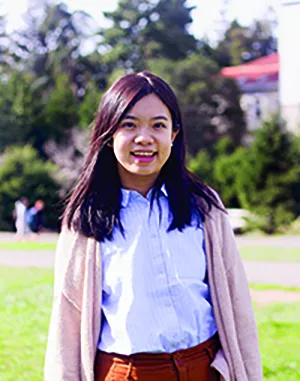The Way to Waymo
Reaping the benefits of Bryn Mawr and Caltech to find a place in tech
For Bryn Mawr students with an engineering mindset, the 3+2 program offers the opportunity to earn both an A.B. from Bryn Mawr and a B.S. from Caltech in five years. This was the route Jiabin Liu ’14 took, and the combination of experiences set her up well for her career in Silicon Valley, where she is currently a data scientist at self-driving car company Waymo.
Why Bryn Mawr?
When I was in high school, I was really strong in science, but I was also a really big fan of Russian literature. At a place like Bryn Mawr, all kinds of options are open.
Why Caltech?
In my second semester at Bryn Mawr, I took a class in physics. May Cheng was the lab instructor, and I really enjoyed her way of teaching and asked if could join her lab. She very generously said yes. Because I did well in physics classes and enjoyed research, the department told me about the 3+2 program.
How did the two experiences compare?
One thing the two schools have in common is that they’re both small and everybody knows everybody. The academic experience is very different because at Bryn Mawr every class was very intimate in size. So even for an intro class, there would be no more than 20 people. At Caltech, I was sitting in an auditorium with maybe 100 other people. The professors are great—they are the top in their field—but they engage less with the students.
How did Caltech lead to Silicon Valley?
At Caltech, I majored in applied physics and took a lot of engineering and math classes, then pursued a Ph.D. at Berkeley in atmospheric physics. Right in the middle of my Ph.D., I felt I wanted to try something outside of academia because I’d been in school for such a long time. In 2018, I did an internship as a data scientist at Airbnb.
I actually felt it was quite similar to doing research in that you have all these equations and you have this vast amount of data that you are trying to make sense of. Using a programming tool, you try to draw some patterns. The only difference is that in academia, once you draw the pattern, you write a paper about it and then you publish. At a tech company, once you draw a pattern, you take some action to make the product better for users. The feedback loop is a lot shorter than in academia. After Airbnb, I did another internship, at Google X, which is where I learned about Waymo.
What do you do at Waymo?
My day-to-day involves developing metrics and methodologies to quantify how safely the Waymo driver is driving, how we compare to the national average of human drivers, and how much our autonomous driving technology is improving month by month, quarter by quarter, year by year.
Why should we be excited about self-driving cars?
Autonomous vehicles are one of the most exciting cutting-edge technologies of this decade or even this generation. They really can change a lot of aspects of our lives. Right now, when we drive a long distance, we need several human beings so that we can rotate and not be too tired. With the autonomous vehicles, that won’t be an issue anymore. It also provides mobility to people who are not able to drive for various reasons. This service, by the way, is already available, in Phoenix. It’s like an Uber app that you can download, and then you can hail a car without a human driver.
Any downsides to working in tech?
Silicon Valley is still a very male-dominated working environment. My Waymo team is surprisingly balanced. We are constantly making efforts to create a more diverse and inclusive environment for everyone.
Published on: 02/10/2023
